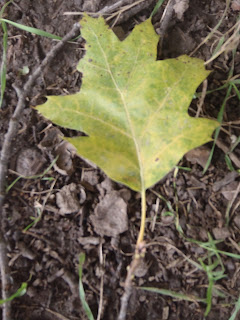With the arrival of autumn, our nature kindergartners dug deeper into our study of trees. We've discussed parts of a tree, types of trees, life cycles of the tree, and needs of the trees, so today we focused our attention on how a tree changes over a single year and how animals might use the tree throughout the seasons.
We read A Tree For All Seasons by Robert Bernard. It provided examples of a how a maple tree changes throughout the year, We then compared to that to our big oak tree that serves as one of our outdoor classrooms. Then, on our special hike, we stopped at some new and some familiar trees to see how the tree might be used. Our first stop was at a new tree just off the trail. When we inspected the side normally hidden from view, we found a large cavity and some critter holes near the tree's base.
We then stopped at the place the kids now call "sapling forest" because of the young trees. Besides enjoying meandering through the maze of thin trunks, students enjoying shaking leaves out of the trees.
While there, we saw even more examples of how animals might use trees. With many trees full of tiny holes, kids made predictions that woodpeckers and/or bugs had made a visit.
We put it all together and realized that a tree is used throughout the year for different reasons. From nests in spring, shade in summer, and food storage in the colder months, trees are important. Plus, even trees that have fallen and are dead can be full of life.
After snack, natural play time led to some new adventures. At the rock pile, students figured out that some rocks could write on others. It was fun to see kids using their self-proclaimed "chalk rocks" to draw designs on other rocks.
Over the last week, I used funds generously donated by a school family to add some storage benches around the trail. In one of these benches, I put another generous donation: corn. With a basic introduction to how animals were preparing for winter, we decided to each take some corn and find a spot for our animals to get a treat.
Most thought the floor of the oak tree classroom was a fine spot. We will check in tomorrow to see how much remains.
Last year, throughout the month of October, the students collected leaves from all over the land and created a pile of leaves to connect to a picture book about a huge leaf pile. We started this year's collection today and found lots of things along the way. From fungi to rocks to what we think was a decomposing opossum, we certainly explored nature up close and personal.
We'll continue to add to the pile throughout the month and see how it grows as the weeks progress.












No comments:
Post a Comment